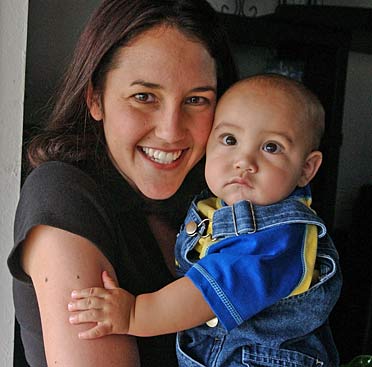
|
Cord blood bank
hopes to build on
its lifesaving success
When Leigh Faria's first child was born on May 30, she did not hesitate to donate the umbilical cord blood to the Hawaii Cord Blood Bank so someone else could live.
Donation is free and anonymous
Women considering donating umbilical cord blood to the public Hawaii Cord Blood Bank after their baby is delivered should decide by the sixth month of pregnancy.
They should be at least 18, in good health, with a normal pregnancy. They only need to fill out a screening form. There is no cost to the family and the donation is anonymous. To sign up as an umbilical cord donor, obtain more information or contribute to the Hawaii Cord Blood Bank, call 983-BANK (2265) or see the Web site: www.HCBB.org.
Star-Bulletin staff
|
Faria, 25, of Kaneohe, teaches kindergarten and first grade in the Hawaiian-language immersion program at Waiau Elementary School. She had decided to make the donation long before she gave birth.
She said Candido Barbieto, father of their son, Kaha, was "real supportive. ... It was just so easy.
"They should make everybody do this."
Umbilical cord blood contains the same rich stem cells as bone marrow and can be used to treat patients with cancer and other life-threatening diseases. The blood is collected from the umbilical cord after the baby is delivered.
Cord blood donated from Hawaii newborns has already resulted in four matches to Asian patients on the mainland with aggressive forms of leukemia, said Dr. Randal Wada, founder and medical director of the Hawaii Cord Blood Bank.
The volume drawn from the umbilical cord comprises a unit. Some are bigger than others and suitable for larger patients, Wada said. "More is better."
The first cord blood unit matched from Hawaii went to a 49-year-old woman in Illinois last August; the second, in September, to a 2-year-old boy in Minnesota; the third, in November, to a 17-year-old girl in Texas; and the fourth, last week, to a 15-year-old boy in North Carolina.
"These four people had a second chance from something we would have tossed in the trash," Wada said. "This is recycling someone's life. It's quite remarkable," he added, noting the young Hawaii bank has collected only about 550 units. Most cord blood banks only start getting matches after an inventory of a couple thousand blood units, he said.
The nonprofit Hawaii Cord Blood Bank is one of fewer than two dozen public cord blood banks in the country and the only one in the Pacific. Thus, cord blood collected from Hawaii's racially diverse newborns greatly increases chances of a match for patients with aggressive cancer, Wada said.
The Cord Blood Bank collaborates with the Blood Bank of Hawaii and the Puget Sound Blood Center in Seattle. The Blood Bank sends the cord blood within 24 hours after it is collected to Puget Sound where it is processed, tested, preserved and entered into the National Marrow Donor Program's cord blood database.
Mothers donating cord blood will never know if it saves anyone's life, Wada noted, but for every match, "a mother can look at her baby and say, 'It could have been you.'"
A molecular biologist and bone marrow transplant surgeon at the Cancer Research Center of Hawaii, Wada performed the first cord blood transplant at UCLA Medical Center in 1996, saving the life of an 8-year-old boy with leukemia.
He established the Hawaii Cord Blood Bank in 1998 with the Kapiolani Medical Center for Women & Children and an initial contribution from Emily O. Castle.
"It's such a wonderful program," Castle said, expressing pride in the four patient matches to date.
The Queen's Medical Center, Kaiser Permanente's Moanalua Medical Center and Tripler Army Medical Center are participating in the program, as well as Kapiolani.
The program depends on donations to cover costs of about $75,000 to $100,000 a year to collect, process and store the blood. "This is like a little garage cord blood unit, operating on a shoestring and the aloha of hundreds of doctors and families," Wada said.
But now that it is getting some matches, he said, the program hopes to become self-sustaining. It is seeking state funding to help with operational expenses and is negotiating with the Puget Sound center to share third-party reimbursements for cord blood matches and federal payments for recruitment of minority donors.
The program also is seeking a closer partnership with the Blood Bank of Hawaii, which has a federal grant to build and staff facilities to store and process cord blood, Wada said.
Lynette Matsumoto, the program coordinator, says it is "more of a cause, a mission, than a job."
Her son died of leukemia at age 12. One of her two daughters, now 21 and 16, was a match for a bone marrow transplant, which Wada performed at UCLA. However, there were complications with a fungal infection, Matsumoto said.
Wada invited her to join the Cord Bank last September. "It was a way of me helping other families going through the same thing," she said.
"The pain never goes away, but it gets better every day when I speak to a mommy. ... It's my way of giving back for what people have done for our family."
Lisa Wong-Yamamoto, Kapiolani labor and delivery nurse and cord blood educator, said misinformation, language barriers and a 10-page front and back screening form discourage some women from signing up as cord blood donors.
Kapiolani has about 500 deliveries a month, and each of the other three participating hospitals has about 200, Wong-Yamamoto said. "If we can collect half of those, that would be wonderful. That would be like a dream."
[News] [Business] [Features] [Sports] [Editorial] [Do It Electric!]
[Classified Ads] [Search] [Subscribe] [Info] [Letter to Editor]
[Feedback]
